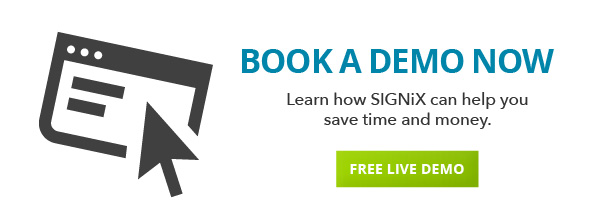If you started to make a list of the most annoying logistical elements of any job, where might you begin? Most people wouldn’t get too far down a list of logistical hassles before they brought up signatures. Some of the typical pain points include:
Numerous business documents and forms require a signature, often at different stages of a process.- It’s often easier for companies to do this digitally, but …
- … companies may use different e-signature processes.
- The approaches don’t always “talk” to one another and, as a result …
- … storage of previously-signed documents becomes a hassle.
The first step in the process is finding your signing solution. In the modern business environment, you look for a signing solution based on the three “anys,” notably:
- Anytime
- Anywhere
- Any device
If you miss one of the, “anys,” you’ve got a problem. What happens if your team is spread across different time zones? “Anytime” now is a concern. What about if your sales reps tend to travel all week? “Anywhere” and “any device” now come into question.
One of the simplest rules of work, in general, is that people tend to navigate to the easiest solution possible, and it must be easy to use across various situations. This is particularly important for an e-signature solution. That’s why cloud-based SIGNiX makes so much sense. It’s ironclad in security and exceptionally user friendly. In addition, with the legal evidence embedded in the signed document and independently verifiable using any PDF reader, a company’s ECM can be the ultimate storage solution with no need for additional copies to be saved in less secure locations.
But finding an easy-to-use and secure e-signature service is only step one. Step two is looking at where the forms are ending up. Where are they being stored securely after the signing phase is done?
That’s where enterprise content management (ECM) systems come in. ECM programs capture, manage, store, preserve, and deliver content and documents through an automated platform. So once documents have been signed electronically, the management of those documents becomes significantly easier. The same can occur when managing e-signed forms inside an ECM platform.
A module for signature-based forms should meet certain standards
A PDF and Word forms capture add-on—an application that reads, transfers data and files, and processes digital forms—for ECM programs can be a valuable tool in addressing the pain points that arise when digital forms become part of a business operation. But these programs should first meet certain standards.
Such applications should:
- Register input.
- Save a copy of the form.
- Automatically create a filing structure.
- Initiate a workflow process. (That is, the forms are automatically routed to the party that needs them next, making the form submittal process faster and more efficient.)
The least frustrating application maps field values in your PDF or Word form template to indexing fields in your filing application. Once a recognized form type is detected, the application automates the data entry, saving the index values with their image. The form can then be automatically emailed, archived, or immediately integrated into a workflow.
Safely storing files
It’s also important to store signed PDF and Word document forms in a reliable, redundant location, accessible to the people who need them.
Consider who will need these forms and documents. Should they be restricted to top-level executives? Do these forms need broader cross-functional access? Will some employees need to modify forms and documents, and should other departments only be allowed to read them?
Regardless of how forms are shared internally, today’s cyberattacks require any organization using a document and forms management system to deter unauthorized external access to individual files.
Layered security, such as 128-bit encryption combined with configurable user access management, provides optimal protection and practical ways to deliver files to the right people at the right time. Choosing the right cloud partner and server with strong security resources can also help ensure that files are safe and accessible only to the right people.
A solid enterprise content management system and a reliable digital signature solution go hand in hand. Make sure the thousands of forms and documents you may encounter in a given week are signed and stored in a reliable, repeatable, secure process.
Ted Bauer is a content contributor for Computhink, an ECM solutions provider for secure information sharing and compliance.
To learn more about managing the hassels of business with e-signatures, schedule a free demo.
%20formatted-1.png?width=2528&height=739&name=SIGNiX%20Logo%20Main%20(white)%20formatted-1.png)

